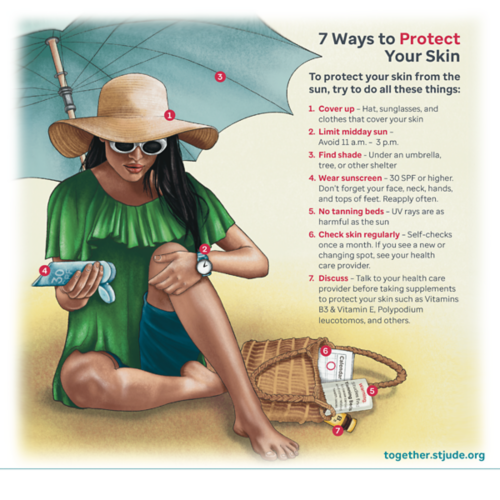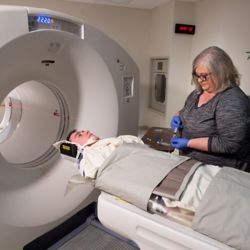Protect Your Skin: Tips from Cancer Survivor, Dermatologist

Maren Davis is a brain tumor and skin cancer survivor.
When Maren Davis was 6, a mole on her left cheek changed from brown to a light, almost translucent color.
Just 3 years earlier, Davis had been treated for a brain tumor called atypical teratoid / rhabdoid tumor (AT/RT). The mole appeared in an area where she had received radiation treatment.
A mole that changes in appearance can be a sign of skin cancer. Although rare, radiation treatment can raise the risk of skin cancer. It usually happens in the areas that have received radiation.
Doctors removed her mole. When it was looked at under a microscope, it showed signs of cancer. Davis had melanoma, the most aggressive form of skin cancer.
Skin cancer is common
For childhood cancer survivors treated with radiation, skin cancer is the most common second cancer. It is also the most common cancer in the United States.
For Davis, her skin cancer diagnosis in 2007 was an unwelcome surprise.
“I had never heard of melanoma,” she says. “I was kind of nervous about how the doctors would treat it.”
Davis had surgery to remove tissue around where the mole had been. This was done to get rid of any other cancer cells that might remain. The surgeon also removed lymph nodes from her neck to see if the cancer had spread to her lymph nodes. Luckily, it had not.
Then in 2008 and 2009, reddish moles appeared on her neck. They were removed and sent for testing. In both cases, they were basal cell carcinoma, the most common type of skin cancer in childhood cancer survivors.
Davis, a student at Lone Star College in Texas, has been cancer-free since 2009.

Prevent skin cancer
Because of her history of skin cancer, Davis protects her skin whenever she goes outdoors. She wears a hat, sunglasses, and sunscreen. She takes care to cover a bald spot on her head that was caused by radiation.
“Always protect yourself when you’re out in the sun, and don’t get a sunburn,” Davis says. “It’s a lot better than getting skin cancer.”
She checks her skin regularly for possible signs of skin cancer. She also advises everyone to pay close attention to any changes in your skin:
- Check for moles that have changed in size, shape, or feel.
- Look for anything unusual such as new lumps, sores, red or brown spots, or rough patches.
- See your care provider if you notice changes. It is also important to have a health care provider do a full-body skin exam at least once a year.
“The thought of cancer might be scary, but don’t be afraid to take care of your health,” Davis says.
Advice from a skin expert
The goal of skin checks is to find skin cancers when they are as small and as easy to treat as possible, says Ashfaq A. Marghoob, MD. He is a dermatologist and director of Memorial Sloan Kettering Cancer Center’s regional skin cancer clinic in Hauppauge, Long Island, New York.
“That requires a combined approach of having survivors examine their skin for anything new or changing and having a physician examine their skin regularly,” Marghoob says. “The self-exam and physician exam should be considered as complementary since survivors will find lesions that physicians won’t, and vice versa. Most of the time, when patients notice something new or changing it will be totally fine and we can reassure them that this is a benign (not cancerous) growth.”
You can find free skin screening locations on the American Academy of Dermatology website. Visit the Together by St. Jude™ online resource to learn more about preventing skin cancer.





